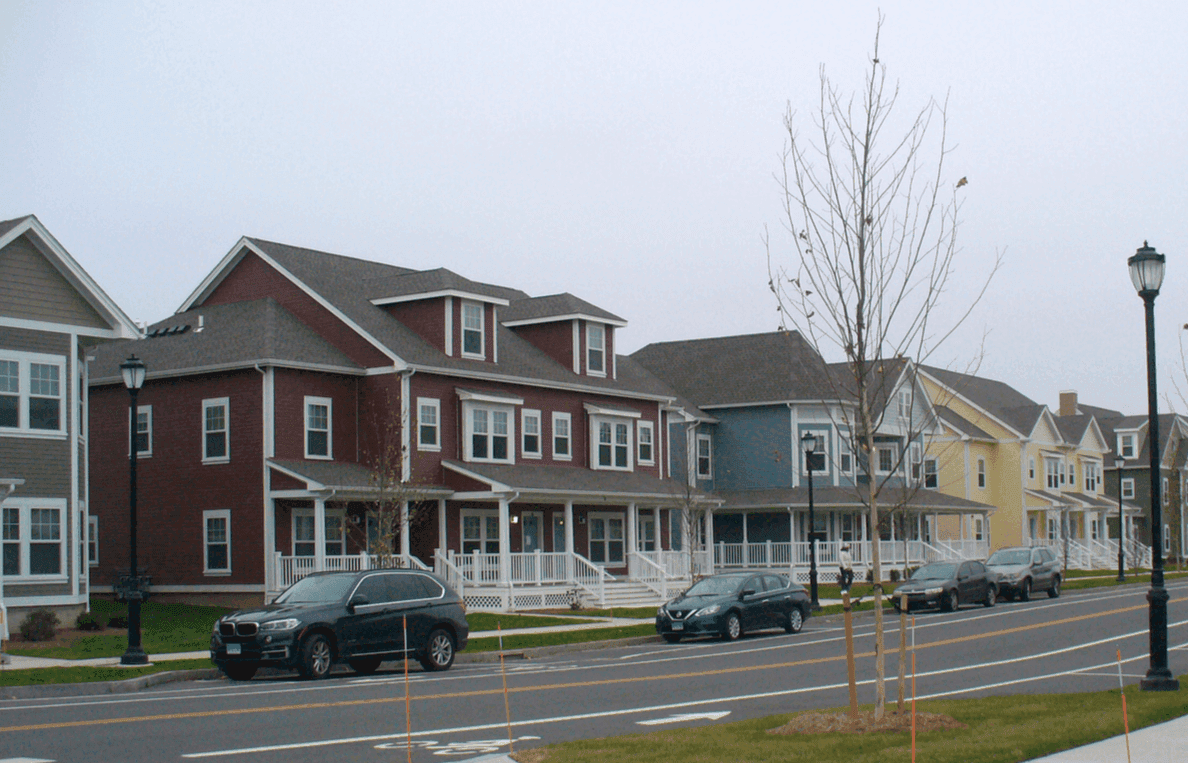
News
By Jeri Mintzer, Courtney Cole, November 5, 2025
To build more homes in the right places at the right price, we must start by modernizing the outdated rules. Zoning regulations artificially limit housing supply, and are one of the most immediate levers to pull in order to stimulate housing supply. Last year, Smart Growth America launched the Center for Zoning Solutions to tackle the zoning barriers to building more homes where they’re needed most.
Many zoning codes reflect outdated ideas that restrict housing types and limit the number of houses that can be built, which drives up costs and reinforces patterns of racial and economic segregation. By prioritizing the modernization of these codes, we can unlock housing supply, provide people with more options for where they can afford to live, and ultimately, make communities more inclusive and resilient.
Much ado about zoning
Zoning is the silent culprit of our current housing crisis since zoning laws control what gets built and where, how tall buildings can be, how many homes and what sizes can fit on a piece of land, how much parking is required, and even who can live together in one housing unit. And in most places across the country, those rules were written to support one kind of housing—single-family homes, on large lots, in neighborhoods that require cars to live there. This means that it limits housing that is close to the things that matter most, like jobs, transit, and schools.
Single-family homes in the suburbs may work great for some families. But housing isn’t one size fits all—people have a diverse range of needs and living situations. When one type of housing is heavily incentivized—such as the single-family home in the U.S.—it means other beneficial types of housing are deprioritized. For example, where multifamily housing is allowed, it is typically restricted to a relatively small area and is often disconnected from the larger community and daily needs, forcing community members to own personal vehicles, which makes the cost of living even more expensive.
How did we get here? Some zoning history
While today zoning is mostly controlled at the state and local levels, the federal government played a central role in establishing the use-based zoning system that has dominated for the past century. Starting in the 1920s, the Standard State Zoning Enabling Act, the Standard City Planning Enabling Act, and the Supreme Court’s decision in the case of Village of Euclid v. Ambler Realty Company all established and solidified “Euclidean” zoning practices. The U.S. Department of Commerce put its thumb on the scale by releasing model zoning and planning laws for states that promoted the separation of land uses into low-density, single-use districts.
Since that initial stamp of approval, the federal government has largely stepped back after delegating these powers to the states, which, in turn, passed them down to local jurisdictions. Without federal guidance, comprehensive zoning reform has largely floundered at the local level. The federal government helped create this system; it should take responsibility for fixing it.
While overt housing discrimination has been outlawed for decades, many development standards—regulations in a zoning code that determine physical characteristics such as lot size, building height, setbacks, lot coverage, density, parking requirements, and more—remain optimized for single-family houses. These regulations can even include implicit and explicit bans on multifamily housing and rules that govern the number of non-family members who can share a home. Development standards can and should be reformed as part of larger zoning reform or on their own.
Zoning as a solution
Many cities have begun to address the issues that zoning created, but overcoming a century of the Euclidean zoning model, which prioritizes the development of detached, single-family neighborhoods with large minimum lot sizes, is no small challenge to face. In most communities, this pattern is allowed by right, while other types are subject to cumbersome discretionary review. Even when zoning allows certain developments like multifamily, they rarely happen because of high costs, longer timelines, and local opposition. These challenges to diverse housing types limit the housing supply and significantly contribute to people not being able to afford the homes in the communities they want to live in.
While zoning has historically been one of the main causes of the housing crisis, it is also one of the most powerful tools local governments have to fix the housing crisis—or at least stop it from getting worse.
Local zoning changes can:
1. Permit more types of housing by right in residential areas, like duplexes, ADUs, or small apartment buildings.
- Zone for what you want: Many communities have multiple layers of zoning red tape, all dictating what can and can’t be built. Imagine trying to build something different and needing to refer to esoteric documents like a base zone, plus an overlay, then another set of rules—all that work creates huge barriers. Rather than aiming to restrict development to only one kind of home, we should allow flexibility for a variety of homes to be built, and let the market respond to the needs of your community.
- Modernize your development standards: If you’re zoning for what you want and a wider range of housing options, things like setbacks, parking minimums, and more all work against those goals. Get rid of them or make them as flexible as possible.
- Make it the easy choice to develop housing: Streamline permitting by allowing all housing types in all residential districts, adopting pre-approved permits for missing middle housing types, and/or adopt infill housing development overlays to facilitate missing middle housing units.
1. Minneapolis 2040: Broad land use and zoning reform that addressed parking requirements, created new zoning districts, established building height minimums in some areas, and allowed duplexes and triplexes on all residential lots. Learn more >>
2. Clallam County, WA: 2022 zoning reform to permit multifamily housing. The advocacy campaign was led by the local chapter of Habitat for Humanity.
3. Montana: 2023 state-wide legislation to expand housing supply, including allowing duplexes and accessory dwelling units on single-family lots by right.
2. Build housing in the right places and make better use of land, especially near jobs and transit, by incorporating housing near everyday amenities, which in turn decreases sprawl and congestion
- Rethink subdivision regulations: Subdivision regulations, as their name suggests, govern the division of large parcels, but they also define the layout of lots, blocks, and streets, as well as the placement of roads, easements, parks, and public rights-of-way. These regulations play a pivotal role in shaping development patterns and can either facilitate or inhibit sprawl by determining how greenfield sites are developed. Reform is essential to accommodate and encourage density, “missing middle” housing, and smaller lot sizes, all of which are needed for a community to efficiently grow its housing supply.
- Use PUDs to achieve housing goals: A PUD (Planned Unit Development) allows flexible, negotiated zoning for large sites, typically focused on mixing housing types, commercial uses, and open spaces under a single, and cohesive development plan. PUDs can also and encourage large-scale, mixed-use development, incorporate public benefits like affordable housing, parks, or infrastructure, and attract private investment with predictability
- Consider an Infill Housing Overlay (IHO): Overlays “lay” additional regulations over existing zoning districts. An Infill overlay specifically modifies existing zoning in targeted areas (often older neighborhoods or corridors) to encourage the addition of housing on vacant or underused parcels. Overlays can add gentle density or missing-middle housing, protect sensitive environmental areas, preserve historic buildings, and promote specific types of development.
1. Massachusetts MBTA Communities: Creates zoning that encourages new missing middle housing in areas served by public transit rail.
2. Richmond, VA Infill: A church is working to convert a parking lot into 192 apartments and 40 townhomes.
3. Lower the price for both builders and buyers/renters, by removing things like excessive parking mandates—the cost of which is often hidden or passed on to consumers—and updating the way we finance housing construction.
- Let the market decide on parking: Parking can add huge costs to the cost of building homes. Consider a zoning text amendment to change required parking minimums to parking maximums, or eliminate minimums and instead allow the market to determine the amount of parking needed.
- Embrace manufactured housing: New technologies have allowed manufactured housing to be built better, faster, and cheaper. Allowing manufactured housing units in all residential zones by right is a key first step, while also working with developers to ensure that cost savings are passed on to end-users. Units with HUD Code Stickers can help ease design review standards and raise the cost of units. Additionally, ensure that design standards don’t add to the cost of the unit.
1. Atlanta BeltLine Overlay District: Removes parking minimums within a half-mile zone of the BeltLine trail and light rail system.
2. Bozeman, MT: Development of a 5.5-acre, city-owned lot into affordable housing.
Zoning reform is an essential tool for smart growth, and using it effectively doesn’t mean getting rid of single-family homes. The goal is to give people more choices—and create room for the kinds of homes and communities that work for people today, rather than continuing to let outdated rules shape what and how we build, and who we build it for.
Related News

© 2025 Smart Growth America. All rights reserved
Site By3Lane Marketing














